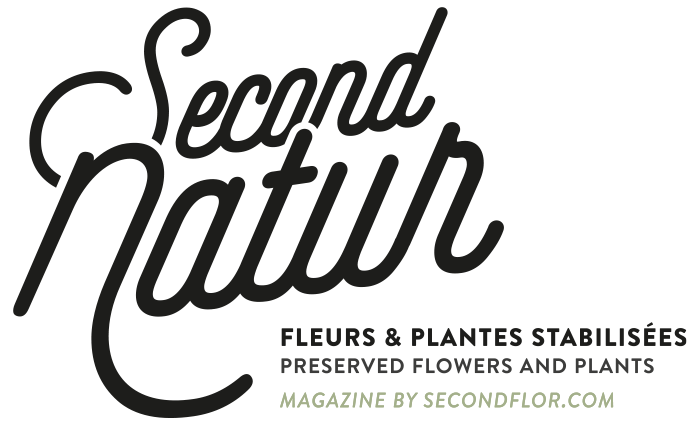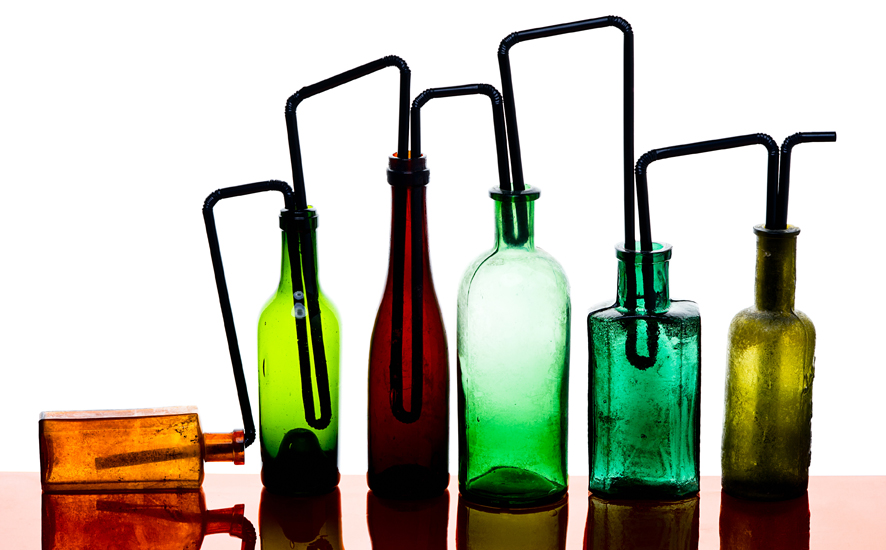There are many techniques to conserve plants. However, we can consider that the technique of capillarity is the most noble. It is also the most risky. Its nobility lies in the fact that we work on a fresh material which is still alive. Like a transplant, the plant must accept its transformation for the success of the process.
This technique mainly concerns foliage and trees. Another technique should be used regarding flowers preservation.
What is the process to do a stabilization by capillarity ?
The capillary stabilisation process
Whether it is for a foliage or a complete tree, it is necessary to cut the plant at the level of the stem. Otherwise, the roots act as a filter and prevent the stabilizing liquid from circulating in the plant.
In a room with controlled temperature and humidity (around 24°C/75,2°F and 50% humidity), the plants are soaked by the foot in 5 cm of stabilizing solution. By means of capillarity, the substitution fluid spreads in the plant through the stems and the leaves. After a few days, the plant is saturated. We take it out of the gutters to dry for 24 hours since it has been sweating a lot. The plant is stabilized and therefore ready for sale.
The risks during the stabilization by capillarity
This technique is very risky because the result is not guaranteed. Climatic deregulation, changes in the production of fresh plants, changes in plant varieties… all these parameters can generate dysfunctions. Without easily identifiable reasons, it is not uncommon to have to throw out a whole production. The plant may refuse to “drink” the liquid or reject it posteriorly, sometimes even several weeks later. This can lead to significant losses since up to numerous tons of plants can be produced during the same session. This risk is often passed on in the price of the plants to ensure the survival of the business model of the stabilized plant producers.
There is a unique process for each plant variety
In the stabilizing liquid, there is glycerine of vegetal origin. It is diluted in a large volume of water, and together they will fill in the interior of the plant. Powdered food dyes are also added. Starting from the primary colours, we can recreate almost any shade.
It is necessary to nourish the plant during the process of absorption. That is why the right nutrients are added for each variety in the right proportions. As each variety is unique, they each requires different nutriments.
Similarly, the differences in fibre density, period of activity and nature of each variety require specific treatment. The temperature of the stabilizing liquid, the period of stabilization, the duration of the absorption process, the maximum time between cutting and setting in the stabilization room, the tool for cutting the plant are all factors specific to each variety. Fascinating, isn’t it?
The particular case of preserved statice
There are even additives to stop the liquid before entering the flowers. This helps preserve the natural colour of the flower while stabilizing the stem. The statice for example has a dried flower and this technique is perfectly appropriate. Note that for the rose on stem, only the stem is stabilized by capillarity. The flower is stabilized by another method. The two elements are then assembled manually.
How are the different colours given to each plant?
Even if the preserved plant is sold in its natural colour, it will need colouring. Why? Because the green of the plant comes mainly from the chlorophyll maintained by photosynthesis. Once stabilized, the plant is no longer alive. Photosynthesis no longer works. It is then necessary to add the colourant to maintain the original colour. As the dermis of the trunk and branches is thick, the dye does not ascend to the surface. These parts therefore retain the “wood” colours of the living plant. On the other hand, the leaves display the colour of the dye. This is why stabilized foliage is true to the fresh plant.
Recently, we found that exposing foliage to natural light after the stabilization phase allows for the complete dissection of chlorophyll and thereby sublimates the colours of the treated plant.
What are the advantages and the constraints of this technique?
Once stabilized, these plants have many advantages. Obviously, they no longer require any maintenance, water, or light. It can be deconstructed and every part of the plant can be used as a material in its own right. This allows you to express your creativity by using each element of the plant independently.
However, preserved plants have their limits. As they do not have the ability to regenerate, any damage is permanent. Moreover, these plants do not tolerate humidity. They are therefore only suitable for indoor use. It should also be noted that for florists with very wet shops, or for installations made in direct contact with sunlight, the flowers, and plants will tend to drip a staining liquid. This is a characteristic that can have serious consequences if not taken into account, for example on unglazed marble, wedding dresses, etc.
However, it can be said without any complexity that stabilized plants are by far the best solution for the use of an indoor plant: better than artificial plants but also, in many cases, live plants…
What are the varieties concerned by this technique?
Eucalyptus (all varieties), cypresses, most forest foliage, hydrangea, statice, some varieties of boxwood, bamboo and olive tree, amaranth, poplar and many others.
Note that this technique is constantly evolving and we find every year solutions for new varieties. This technique also works on whole trees: it takes just longer.
Interesting, isn’t it?

